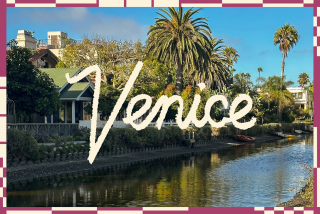ARCHITECTURE : Fantasy Buildings of Old Venice Are Eloquent Even in Their Ruin
- Share via
The most striking thing about Windward Avenue is how much is gone. The place is a ruin, a reminder of the glory of the “Venice of America” that once centered around the four-story luxury hotels and restaurants that lined the street. All that remains is the interrupted cadence of an arcade, a few columns holding up the remains of Abbot Kinney’s dream.
Kinney, who made his fortune selling quasi-Turkish cigarettes, settled in Los Angeles for his health at the turn of the century and found himself, through various real estate schemes, saddled with a large portion of the swamps and dunes that formed the estuary of the Los Angeles River.
Kinney turned the fact that the area would have to be drained to be developable to his advantage by transforming the drainage ditches into a series of canals radiating out from a central lagoon. Naming it after Italy’s city of canals, he supplied the new Venice with gondolas, arching bridges and an architecture modeled after the colorful palaces of its fabled namesake.
Though Kinney saw the town as a classy community grouped around cultural institutions, the town actually became the West Coast’s answer to Coney Island, replete with numerous roller coasters and piers. Connecting the romantic residential neighborhoods around the canals to the continual carnival of the boardwalk was Windward Avenue.
Kinney mandated a “Venetian” style for all the buildings there. The result was a series of stucco structures raised up off the street over an arched arcade. Though most of the elaborately detailed buildings have been stripped of their ornament, you can still pick out the shields, diagonal bands of terra cotta and banded cornices that once turned them into garish displays of architectural fantasy.
What is amazing about Windward Avenue today is how empty it is. Old photographs show the street surrounded by arcaded blocks, crammed with people, and hemmed in on one side by the buildings of the pier and on the other by the “Race through the Clouds,” a predecessor to Magic Mountain. The St. Marks Hotel anchored the street with luxurious rooms provided with both fresh and saltwater.
The reasons for the demise of this once-thriving bit of commercial fantasy were many, ranging from the faulty engineering of the canals to political bickering to the arrival of the car, which made the accessibility of this beach through an elaborate network of streetcar lines less of an advantage.
The final blow came when oil was discovered there in 1929. Overnight, hundreds of oil derricks and all of their noise and smells invaded the quaint backwaters of Venice, driving many people away. The canals were filled in, the amusement piers burned down or were razed, and soon all that was left around Windward was the open sweep of the boardwalk, a traffic circle where the lagoon had once been, and a decaying neighborhood.
The commercial core struggled on, adding neon lights to its arches and turning its restaurants into drugstores, but in 1962 several of the buildings were condemned, torn down and replaced with parking lots.
Strangely enough, the forlorn, seedy side of Windward Avenue has developed its own history and beauty. Home to outcasts and bohemians, it was the background for Orson Welles’ 1958 movie “A Touch of Evil,” which casts it as a Mexican border town hit hard by all kinds of hidden evil symbolized by the nearby oil wells pumping away behind its tarnished facades.
It is the incomplete, faded quality of the arcades, the stripped facades of the buildings, and the memories they represent that still give a sense of romance to this otherwise undistinguished strip of stores. A mural on the side of what was once the St. Marks Hotel imagines the area as a complete ruin, a reminder of fantasies past and future.
More to Read
Sign up for Essential California
The most important California stories and recommendations in your inbox every morning.
You may occasionally receive promotional content from the Los Angeles Times.






